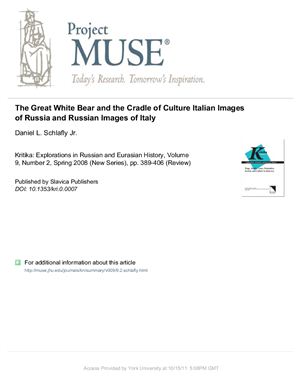Kritika: Explorations in Russian and Eurasian History, Volume
9, Number 2, Spring 2008 (New Series), pp. 389-406 (Review)
Russia’s image and self-image, perhaps more than
any other country’s, has been shaped from abroad.
It is fitting that the director Aleksandr Sokurov chooses
a foreigner, Astolphe Louis L?onor, Marquis de Custine,
to guide viewers through three centuries of Russian
history and culture in the Hermitage in his 2002 film Russkii
kovcheg (Russian Ark). Since Muscovite times, Russia has
looked to foreign experts, whether Italian architects starting
in the 15th century, some discussed in these volumes;
Greeks consulted by Patriarch Nikon in the 17th century;
or Ukrainian clerics under Aleksei Mikhailovich and Peter I,
followed by a steady stream of foreign statesmen, military
leaders, artists, and scholars. The Pole Adam Jerzy Czartoryski,
the Baltic German Andrei Gotthard Budberg, the Greek
Ioannis Antonios Kapodistrias, and the German Karl Robert
Nesselrode served as Alexander I’s foreign ministers.
9, Number 2, Spring 2008 (New Series), pp. 389-406 (Review)
Russia’s image and self-image, perhaps more than
any other country’s, has been shaped from abroad.
It is fitting that the director Aleksandr Sokurov chooses
a foreigner, Astolphe Louis L?onor, Marquis de Custine,
to guide viewers through three centuries of Russian
history and culture in the Hermitage in his 2002 film Russkii
kovcheg (Russian Ark). Since Muscovite times, Russia has
looked to foreign experts, whether Italian architects starting
in the 15th century, some discussed in these volumes;
Greeks consulted by Patriarch Nikon in the 17th century;
or Ukrainian clerics under Aleksei Mikhailovich and Peter I,
followed by a steady stream of foreign statesmen, military
leaders, artists, and scholars. The Pole Adam Jerzy Czartoryski,
the Baltic German Andrei Gotthard Budberg, the Greek
Ioannis Antonios Kapodistrias, and the German Karl Robert
Nesselrode served as Alexander I’s foreign ministers.

